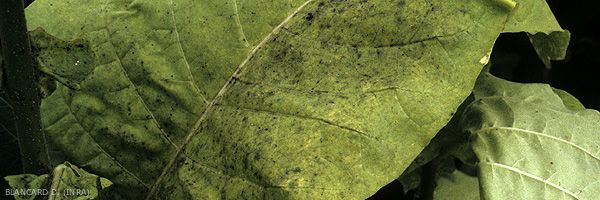
Pests and Sooty mould
The occurence of sooty mould on tobacco (figure 1) is always linked to the presence of parasitic insects on plants. Among them aphids and whiteflies are most commonly associated to black mould on the lamina. The explanation is quite simple and it is related to the feeding behaviour of the insects. The aphids and whiteflies (figure 2) must collect large amounts of sap for the protein they need. This makes them reject the excess sugar in the form of honeydew. It can be found in large amounts in places where aphid colonies grow and taint the surface of the invaded lamina. The sweet honeydew is a real chance for many phylloplane fungi that use it for food and thus progressively the dew is covered by black mould (Alternaria spp. Cladosporium spp. Capnodium sp. ...). The sooty mould certainly disrupts the photosynthesis. It probably has a double impact on the quality of harvested tobacco leaves: it contaminates harvested leaves and indirectly changes their chemical composition.
Aphids and whiteflies not only secrete honeydew, causing sooty mould, but also disrupt the regular functions and growth of tobacco plant. In severe outbreaks of these insects, it is quite common to see reduction or even stagnation of plant growth. The leaves can be of small size and partially or totally distorted. These insects are also effective vectors of several serious viruses of tobacco (see fact sheets of Tobacco viruses).
Other pests, sometimes also virus vectors, grow on tobacco leaves and cause rather different symptoms:
- leafhoppers - cause tiny white lesions scattered on the lamina (figure 3);
- thrips - giving a yellowish to metal tint to the veins and to nearby lamina tissues (figure 4);
- spider mites (acarians) are responsible for large irregular spots on leaves with a dirty yellow colour and silvery reflects (figure 5).
Note that other damage caused by pests are presented in the following topics and themes: Soil pests - Perforated, cut leaves - Bug damage.





